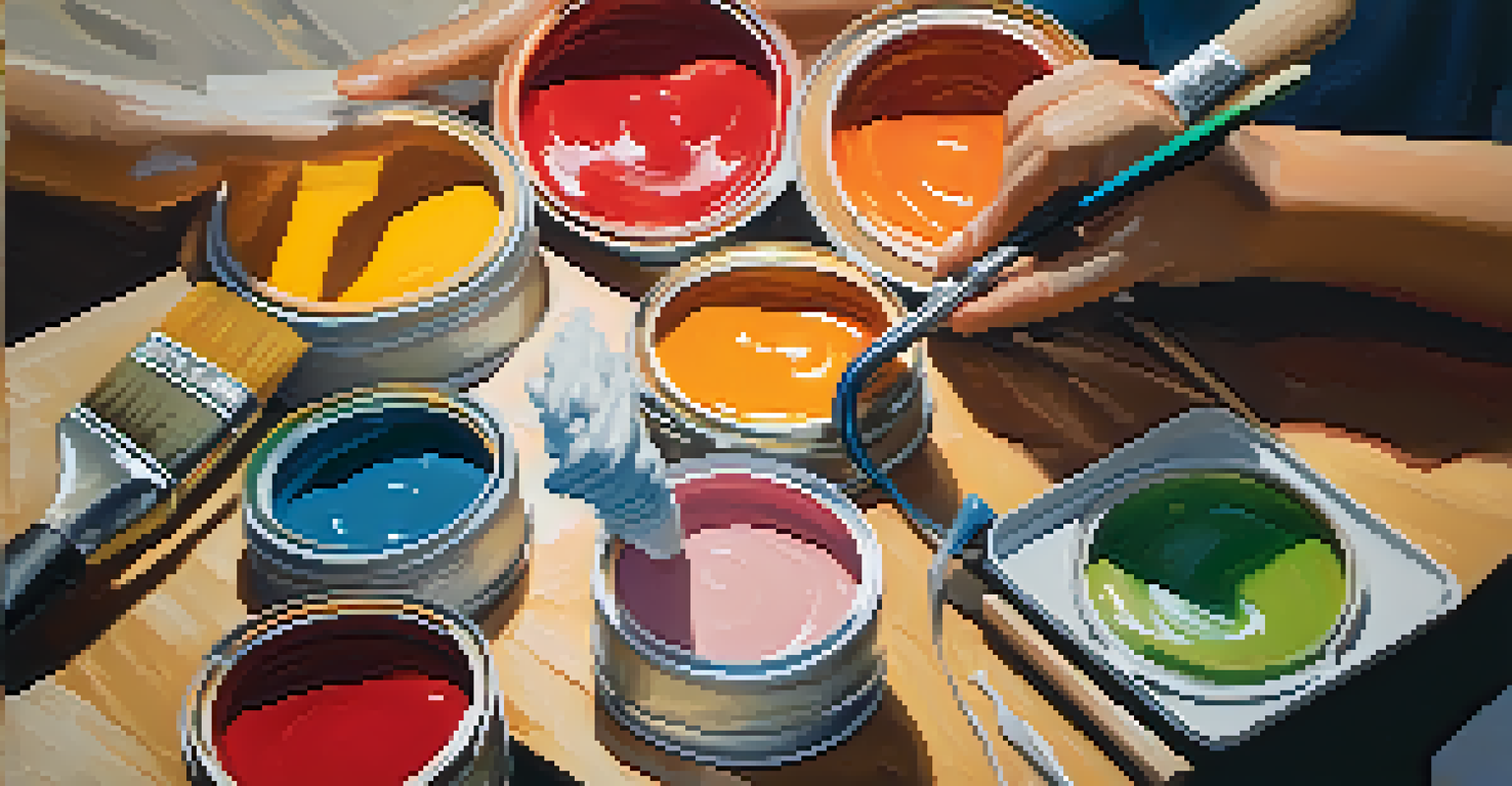Sustainable Practices: The Future of Eco-Friendly Painting

Understanding Eco-Friendly Painting Materials
Eco-friendly painting begins with the materials we choose. Traditional paints often contain volatile organic compounds (VOCs), which can be harmful to both health and the environment. In contrast, eco-friendly paints use natural ingredients and low or zero VOCs, making them safer options for your home and the planet.
The greatest threat to our planet is the belief that someone else will save it.
For instance, plant-based paints and mineral-based pigments are gaining popularity. These paints not only reduce the risk of indoor air pollution but also often provide vibrant colors without compromising quality. Choosing these materials is a simple yet effective way to start your sustainable painting journey.
Moreover, many eco-friendly options come in recyclable packaging, further minimizing environmental impact. By selecting sustainable materials, you're not just enhancing your space; you're also contributing to a healthier planet for future generations.
The Role of Sustainable Practices in Home Renovations
When it comes to home renovations, sustainability should be at the forefront of decision-making. Implementing eco-friendly painting practices not only improves aesthetics but also boosts property value. Homebuyers today are increasingly looking for sustainable features, making your efforts pay off in the long run.

Incorporating sustainable practices can mean reusing existing materials, such as repainting cabinets instead of replacing them. This approach reduces waste and often leads to unique, personalized spaces that reflect your style. It’s a win-win situation for both the environment and your budget.
Eco-Friendly Materials Matter
Choosing low or zero VOC paints enhances indoor air quality and benefits both health and the environment.
Additionally, sustainable renovations can lead to energy savings. By choosing paints that enhance insulation or reflect light, you can create a more energy-efficient home. This not only benefits your wallet but also reduces your carbon footprint.
DIY Eco-Friendly Painting Tips for Homeowners
If you're a DIY enthusiast, there are plenty of ways to ensure your painting projects are eco-friendly. Start by prepping your space with drop cloths made from recycled materials and using brushes that are free from harmful chemicals. This small step can make a significant difference in reducing waste.
Sustainability is no longer about doing less harm. It's about doing more good.
Another crucial tip is to mix your paints wisely. Instead of discarding leftover paint, consider mixing different colors to create new shades. This not only minimizes waste but also allows you to unleash your creativity. You might just end up with a unique hue that perfectly complements your home.
Lastly, remember to dispose of any leftover materials responsibly. Many communities have special disposal days for paint and other hazardous materials. By taking the time to ensure proper disposal, you're doing your part in protecting the environment and promoting sustainable practices.
The Impact of Sustainable Painting on Indoor Air Quality
One of the most significant benefits of eco-friendly painting is its positive impact on indoor air quality. Traditional paints can release harmful chemicals into the air, leading to respiratory issues and other health problems. By opting for low or zero VOC paints, you create a safer environment for you and your family.
For example, studies have shown that homes painted with eco-friendly paints have significantly lower levels of indoor air pollutants. This is especially important for young children, the elderly, and those with respiratory conditions. A simple choice like switching to eco-friendly paints can lead to healthier living spaces.
Sustainable Renovations Boost Value
Implementing eco-friendly painting practices not only improves aesthetics but also increases property value.
Furthermore, enhancing indoor air quality contributes to overall well-being. Fresh, clean air promotes better concentration and mood. By prioritizing eco-friendly painting, you're not just beautifying your home; you're also fostering a healthier lifestyle.
The Benefits of Working with Eco-Friendly Painters
Choosing to work with eco-friendly painters can elevate your sustainable painting project. These professionals are trained in using environmentally friendly materials and techniques, ensuring your project is completed with minimal impact on the planet. Their expertise can guide you in making the best choices for your home.
Additionally, eco-friendly painters often have access to sustainable products that may not be available at your local hardware store. They can recommend finishes and paints that align with your vision while also being mindful of environmental concerns. This collaboration can lead to stunning results that you can feel good about.
Moreover, hiring a professional can save you time and effort. They’ll handle the preparation, application, and cleanup, allowing you to focus on enjoying your newly painted space. By choosing eco-friendly painters, you're investing in quality work that aligns with your values.
Innovative Techniques in Eco-Friendly Painting
The world of eco-friendly painting is constantly evolving, with innovative techniques emerging all the time. For example, some painters are now using clay-based paints that are not only breathable but also help regulate humidity indoors. This method not only enhances aesthetics but also promotes a healthier living environment.
Another trend is the use of natural finishes, such as oils and waxes derived from plants. These finishes are biodegradable and safe, making them an excellent choice for eco-conscious homeowners. They also provide a unique look that synthetic finishes often can't match.
Community Initiatives Inspire Change
Local programs and workshops promote sustainable painting practices, fostering collaboration and reducing waste.
Technology is also playing a role in sustainable painting. Advanced paint formulations that require fewer coats can reduce material usage and labor time. By embracing these innovations, you can achieve stunning results while minimizing your environmental footprint.
How Community Initiatives Promote Eco-Friendly Painting
Community initiatives play a crucial role in promoting eco-friendly painting practices. Many local programs offer workshops and resources for homeowners looking to make sustainable choices. These initiatives not only educate but also create a sense of community around eco-friendly living.
For instance, some communities organize paint exchange events, allowing residents to swap leftover paints. This not only reduces waste but also helps others find the right colors for their projects without purchasing new materials. It’s a perfect example of how collaboration can benefit the environment.

Moreover, community projects often encourage local artists to use sustainable materials in their work. These initiatives highlight the importance of eco-friendly practices while beautifying public spaces. By participating in these programs, you contribute to a larger movement towards sustainability.